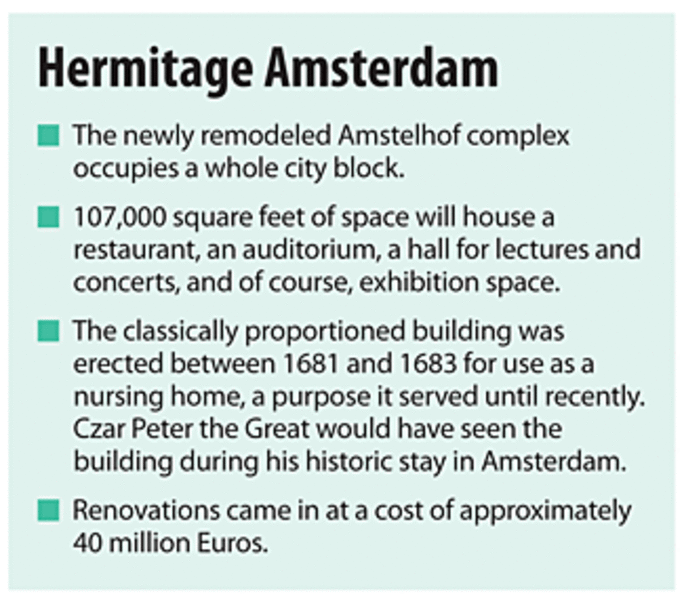In tough times, new Hermitage Amsterdam offers gilded oasis
Loading...
| Amsterdam
The Russian satellite about to debut on the banks of the Amstel River this month will never take flight: its mission is cultural and its structure includes massive stone blocks.
But the launch of Hermitage Amsterdam culminates years of cooperation between cultural leaders in St. Petersburg, Russia, and Amsterdam and represents a new kind of takeoff for one of the art world's giants: The State Hermitage Museum, which holds about 3 million works of art in its vaults on the Neva River.
"These days we've got a lot of adrenaline, in a positive way, because a dream becomes reality," says Ernst Veen, director of Hermitage Amsterdam. The Hermitage "belongs to the world, and we must open it to the world."
The opening Saturday of Hermitage Amsterdam reinforces ties that are as old as St. Petersburg's founding some 300 years ago.
Tale of two cities
The museum will be the first independent institution west of St. Petersburg to bear the name of the Hermitage. Set within the Amstelhof, a hulking 300-year-old former nursing home, the institution will hold exhibitions from the collections of the Hermitage. Spaces for performances, study, and lectures will focus on Russia's artistic heritage.
"The Dutch public are hungry to see more about collections from Russia," Mr. Veen says.
The ties are profound: Czar Peter the Great visited Amsterdam in 1697 seeking inspiration for his new city, which he founded in 1703. Dutch entrepreneurs set up shop in St. Petersburg after its founding and stayed there until revolution exploded in 1917. Grand Duchess Anna Pavlovna, born in St. Petersburg in 1795, became queen of the Netherlands through marriage.
The Hermitage has long collected works from Dutch Masters. Its collection includes the largest holding of paintings by Rembrandt Van Rijn outside the Netherlands.
Hermitage embraces the world
That common history helped draw the Hermitage to Amsterdam in the years following perestroika, or reform. Under director Mikhail Piotrovsky, the Hermitage expanded its presence abroad through collaborations and exhibits, and looked into the possibility of establishing satellites in the West.
"We have established relationships with many museums throughout the world. We've been all around the world, except in Antarctica," says Vladimir Matveev, director of exhibitions and development at the Hermitage.
The efforts include cooperation with other Russian museums worldwide, including the Guggenheim Hermitage in Las Vegas, which closed in 2008 after a seven-year run.
But the relationship with Amsterdam's Nieuwe Kerk stood out. Veen has been its director since the Nieuwe Kerk opened in 1981. In the early 1990s, he began working with the Hermitage on a series of exhibitions of the museum's collections.
By the time Veen was invited to propose a new purpose for the Amstelhof, in the latter part of the past decade, the Nieuwe Kerk and the Hermitage had forged a relationship that made the next step seem natural.
"We know them like we know our own family," Mr. Matveev says.
Veen invited Mr. Piotrovsky to see the complex.
"We were standing in the courtyard, and I said, 'Mikhail, what do you think about the idea to realize a satellite museum of the Hermitage?' " recalls Veen.
Old becomes Nieuwe again
Architect Hans Van Heeswijk, whose firm led the conversion project, says the building's layout made it ideal for public use.
"There are long views throughout the building, with daylight coming in on all sides," Mr. Van Heeswijk says. "It looks much bigger on the inside than it does on the outside. It's very flexible, very solid in its materials."
All set for takeoff
Before Amsterdamers get their first look, the inaugural ceremony for Hermitage Amsterdam will be attended by members of the Dutch royal family and high-ranking Russian officials, including President Dmitry Medvedev.
Amsterdam mayor Job Cohen says the museum's opening underscores the relationship between the two countries.
"There is a close connection that dates back centuries. And I am convinced that the museum will provide a new incentive to cultural relations between Russia and Amsterdam," Mr. Cohen says.
The inaugural exhibition, titled "At the Russian Court: Palace and Protocol in the XIX Century," will feature more than 1,800 objects recreating the court life of 19th-century Russia. Organizers are promising "one of the most lavish [exhibitions] ever presented in Europe," according to a statement.
All of which does create a bit of a jarring impression: a museum of large proportions, opening with an opulent exhibit, in the midst of an economic crisis?
"I always say there was a little angel on my shoulder: Two years ago, I managed to get the five main sponsors for an agreement of five years, starting with 2009, with the opening," says Veen. "And that means until 2013, everything is fixed. And I do believe in 2013, there will be a new financial climate."
Veen emphasizes that Hermitage Amsterdam was able to keep sponsors on board by staying within the budget (about $55 million) and on schedule.
"Everybody by now is very enthusiastic."






